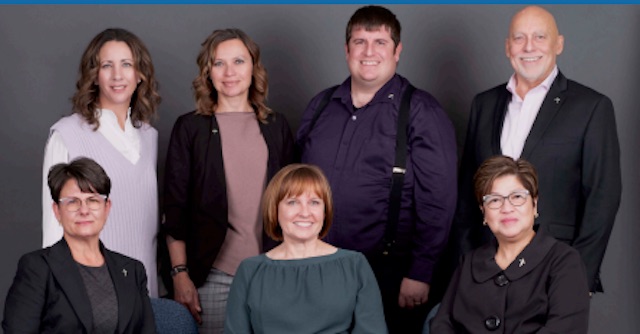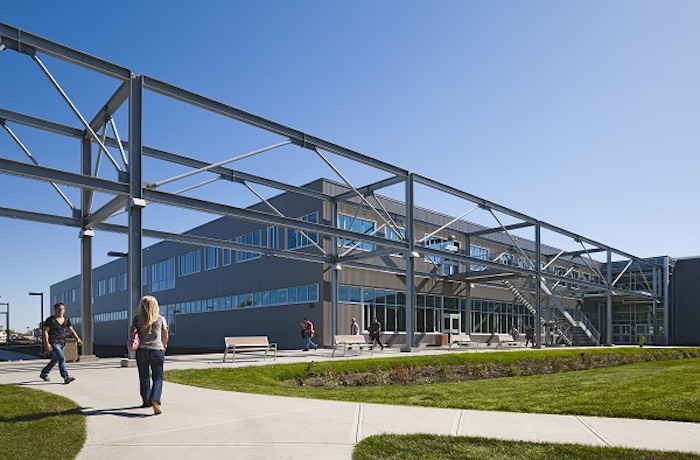Education
Red Deer Catholic Regional Schools – Board Meeting Highlights

From Red Deer Catholic Regional Schools
Inspired by Christ. Aspiring to Excellence.
Board of Trustees
Murray Hollman – Chair, Dorraine Lonsdale – Vice Chair, Sharla Heistad, Monique LaGrange, Cynthia Leyson, Kim Pasula, and Anne Marie Watson
Administrative Procedure 458 – Duty to Report:
The Secretary Treasurer presented the Administrative Procedure 458 – Duty to Report to the Board of Trustees, and highlighted that this procedure was communicated to all staff within the Division. For more information regarding Administrative Procedure 458 – Duty to Report, please click here.
Superintendent Report:
The Superintendent presented the report to the Board of Trustees, emphasizing the first Faith Formation evening for new probationary contract teachers. This gathering, which included administrators and Faith Coaches, senior administration, and trustees, gathered together for Mass held at St. Mary’s Parish on September 19th. The invitation for this Mass was extended to all Division staff via the Superintendent’s Weekly Update and school emails.
The Associate Superintendent of Curriculum shared that RDCRS is taking a measured, teacher-centered approach to curriculum implementation, emphasizing collective leadership and, acknowledging that implementation
is a gradual process similar to learning accommodating various paces and approaches. School administration teams held spring meetings to plan and establish support systems, while the Division has launched a website for
curriculum resources and encouraged schools to prioritize professional learning for this implementation.
This September, students across our Division are also learning from the finalized curriculum in:
• Kindergarten – Grade 3 French Immersion, Language Arts and Literature
• Kindergarten – Grade 3 Science
• Grades 4 – 6 English Language Arts and Literature
• Grades 4 – 6 Mathematics
The Division has also received $227,745.00 for resource allocation and $223,600.00 for professional learning and collaboration for the new curriculum implementation from Alberta Education.
In addition, the Superintendent and the Associate Superintendent of Curriculum met with Red Deer Polytechnic (RDP) President and Vice President, Academic & Student Experience at the Confluence Campus in Rocky Mountain House. The meeting aimed to introduce the new RDP leadership to the facility, assess community needs, and discuss future partnerships, particularly focusing on dual-credit programs and work-integrated learning opportunities for students within the school division. For more information regarding the Superintendent Report, please click here.
Joint Meeting with The City of Red Deer:
The Superintendent informed the Board about upcoming stakeholder engagement meetings and acknowledged the Board’s request for more time for discussions with City of Red Deer Councillors. The Superintendent welcomed suggestions from the Board, and a variety of potential topics were discussed including future land availability for Catholic schools, improved accessibility to recreational facilities, youth and training programs, more frequent review of City transit contracts, safety concerns at the Collicutt Centre, and the potential for recreation facilities to support structured programming. The Board of Trustees is also interested in a GH Dawe Community Centre presentation and how the facility could be utilized by Division schools.
Secretary Treasurer Report:
The Secretary Treasurer provided the Board of Trustees with an update on the St. Lorenzo Ruiz Middle School Capital Project, highlighting the Division’s ongoing efforts to finalize both the school construction and its financial aspects. Additionally, emphasis was placed on the Division’s anticipation and enthusiasm for the upcoming grand opening event of St. Lorenzo Ruiz. For more information about the Secretary Treasurer Report, please click here.
School Bus Advanced Funding:
The Secretary Treasurer shared with the Board of Trustees that on September 8th, RDCRS received notification from Christine Sewell, Assistant Deputy Minister Financial Services and Capital Planning, regarding new funding for school boards managing their transportation fleets. Due to transportation guideline changes for 2023-2024, RDCRS will require 10-15 additional buses. The Division is currently in the process of determining the exact number of buses required before applying for the School Bus Advanced Funding Program. For more information, please click here.
The next Board Meeting will take place on Friday, October 27, 2023 at 1:30 p.m.
Education
Schools shouldn’t sacrifice student performance to vague notions of ‘equity’

From the Fraser Institute
According to a new study published by the Fraser Institute, if Canada wants to remain competitive with emerging economies around the world, we must increase our math, science and reading scores—and not simply pursue high levels of “equity and inclusion” as the primary goal for our schools.
Indeed, highly equitable and inclusive schools—with declining PISA scores, as is currently the case in Canada—do a disservice to students and society at large.
Why? Because higher test scores translate into greater “knowledge capital”—that is, the full body of knowledge available to an economy—and boost economic growth (and, incidentally, the tax revenues that fund our schools).
Indeed, the goal should be equitable access to a quality education. And the most realistic and meaningful way to measure student progress is through PISA tests, which every three years assess the performance of 15-year-olds worldwide in core subjects of math, science and reading rather than the limited curriculum objectives used in provincial testing, which can only show progress or decline within individual school systems. In today’s world, where competition is truly global, we must know how our students and schools perform compared to their peers in other countries, especially the “Asian Tigers” of Hong Kong, Korea, Singapore and Tiawan whose rapidly growing economies have been driven by rising PISA scores.
Obviously, countries with higher test scores can teach other countries how to improve—although there are limits and some traps here. Attempting to cut and paste Singapore’s or Korea’s much more meritocratic systems of highly competitive student assessment and selection would be impractical and impolitic in Canada. Even so, policymakers should consider reinstating more meaningful meritocratic norms in Canadian schools to encourage and recognize academic achievement. Nothing succeeds like success, except recognized and rewarded success.
Closer to home, other provinces could benefit from considering why Quebec is such a stellar performer in math and why Alberta has the highest overall PISA test score average of all provinces.
But fair warning, recent attempts at school improvement in Canada show that top-down one-size-fits-all changes—including extending compulsory attendance, reducing average class size and tinkering with course content—have had little positive effect on student performance, although they may please teacher unions. If policymakers want to achieve more equitable success for more students, they should introduce more flexibility, school autonomy and choice into our top-heavy centrally regulated school systems. In this respect it may be no accident that the three highest performing, mid-spending provincial K-12 education systems (Alberta, Quebec and Ontario) offer relatively high levels of school choice, although of quite different kinds.
Equity and inclusion are noble goals, but they shouldn’t interfere with student progress. There’s too much at stake, for students and the country.
Author:
Alberta
Expansion planned for Centre for Innovation in Manufacturing at Red Deer Polytechnic

Investing in innovation at Red Deer Polytechnic |
Alberta’s government is expanding student capacity and creating a modern learning environment at Red Deer Polytechnic that will help graduates succeed in the economy of tomorrow.
To support emerging opportunities for students, Alberta’s government will invest $12.9 million to expand the Centre for Innovation in Manufacturing Technology Access Centre (CIM-TAC) at Red Deer Polytechnic (RDP). CIM-TAC is an applied research and innovation centre that gives companies access to state-of-the-art prototyping and manufacturing equipment, along with a multi-disciplinary team with the expertise to turn brilliant ideas into market-ready products.
As Alberta’s economy grows and diversifies, job creators will increasingly seek employees with the skills required to work in advanced manufacturing.
Construction will begin in early 2025 and will increase the centre’s applied research, education and training capacity. The expanded CIM-TAC will grow to provide work-integrated learning opportunities for an estimated 450 post-secondary students and training through workshops and events to an additional 2,000 students annually by 2030. Additionally, more than 500 junior and senior high school students will take part in dual credit programs at the CIM-TAC.
“Investing in this expansion of CIM-TAC will give students at RDP access to cutting-edge technology and skills to succeed in the economy of tomorrow. The strategic investments we’re making in Budget 2024 are part of a forward-looking path to support the goals of our post-secondary institutions, grow Alberta’s economy and create jobs.”
“The expansion will allow Alberta-based manufacturers across multiple sectors to have greater ability to develop, test and scale their ideas. Students will be engaged at the forefront of made-in-Alberta technologies and manufacturing solutions.This investment will help meet high demand from entrepreneurs and industry for applied research and will take the facility beyond its current capabilities to become an advanced technology training and hands-on learning centre.”
“This expansion project will build on the CIM-TAC’s 15 years of success and leverage the centre’s industry partnerships and manufacturing expertise to provide even more capacity for applied research, as well as education, training and work-integrated learning opportunities for students. We thank the Government of Alberta for this investment that will benefit not only RDP students and researchers, but also the entire central Alberta region and its critical industries like health care, agriculture, energy and construction.”
“Manufacturing and advanced manufacturing are driving job-creation, economic growth and made-in-Alberta solutions that improve the lives of people around the world and right here at home. The funding to expand RDP’s CIM-TAC is an investment that will allow Alberta companies greater access to the tools, technology and next generation of skilled talent that will allow our industry to solve real-world challenges, develop better products and ultimately increase productivity.”
Quick facts
- The expansion of CIM-TAC at RDP will support a variety of sectors through advanced manufacturing capabilities, including energy innovation, transportation, aviation and agriculture. The centre will also support RDP’s future expansion into more medical device manufacturing and health-care innovations to support both patients and providers.
- RDP’s expansion of the CIM-TAC will grow the facility’s footprint from 15,000 square feet to 25,000 square feet.
- The CIM-TAC currently houses $7.6 million of advanced manufacturing equipment.
- In 2022, RDP attracted more than $2 million in applied research investment. RDP also completed 64 projects for 57 companies and participated in more than 1,300 engagements with industry partners.
- Since the CIM-TAC’s inception in 2009, RDP has supported more than 300 industry partners (including repeat clients).
-

 COVID-192 days ago
COVID-192 days agoThe New York Times Admits Injuries from COVID-19 Shots
-

 National1 day ago
National1 day agoDespite claims of 215 ‘unmarked graves,’ no bodies have been found at Canadian residential school
-

 Brownstone Institute22 hours ago
Brownstone Institute22 hours agoThe WHO’s Proposed Pandemic Agreements Worsen Public Health
-

 Energy2 days ago
Energy2 days agoFederal government continues to reject golden opportunities to export LNG
-

 Energy2 days ago
Energy2 days agoBuckle Up for Summer Blackouts: Wind Is Already Failing Texas in Spring
-

 illegal immigration1 day ago
illegal immigration1 day agoPanama’s Incoming President Wants To Shut Down His Country’s Most Treacherous Route For Migrants — But Will It Work?
-

 conflict2 days ago
conflict2 days ago‘It Makes No Sense’: Experts Puzzled By Biden Admin’s Claim That Rafah Invasion Wouldn’t Help Israel Defeat Hamas
-

 COVID-192 days ago
COVID-192 days agoFormer COVID coordinator Deborah Birx now admits jabs could have injured ‘thousands’






